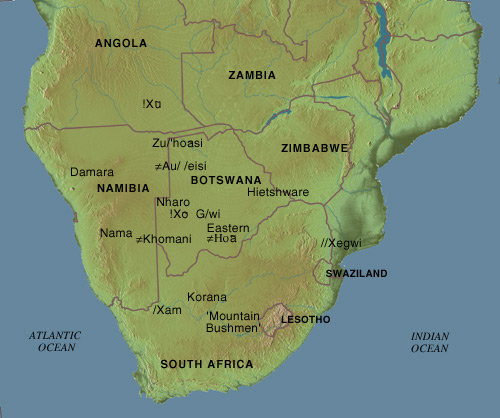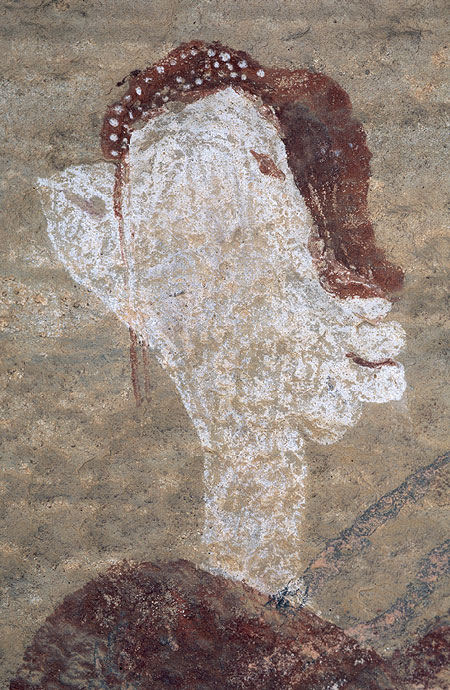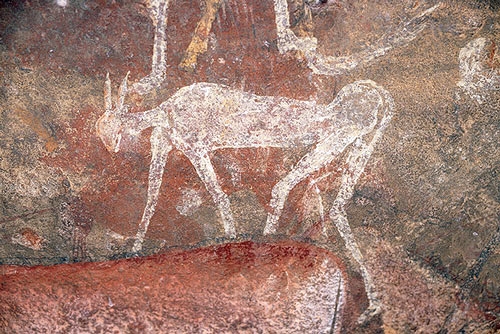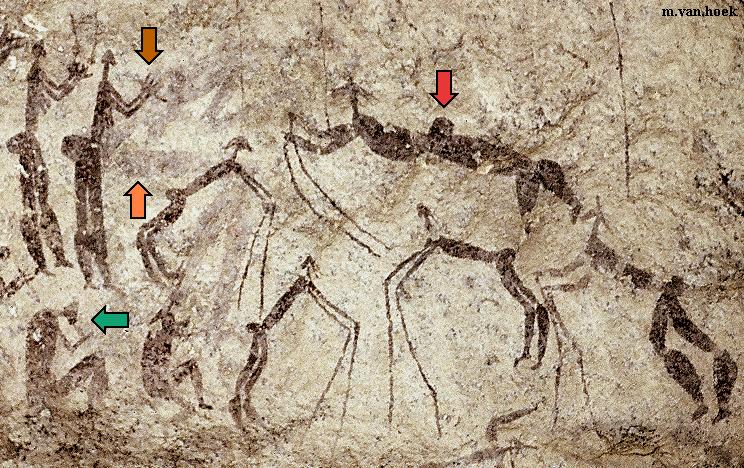SAN

Geographical locations of major Khoisan speaking groups.

Situated just south and east of Lesotho, the shaded portion highlights Nomansland, one of the last sites where the San people painted.
 The San were a hunter-gatherers
population of South Africa (40.000 years ago). They have left a lasting
record of their
life through thousands of paintings – rock art. Though more closely related
to their cultural and spiritual life, many of the paintings give a San
perspective on those who came into their land and displaced them. In
particular those paintings show sheep, sailing ship, horse-drawn wagons and
images of San being hunted by rifle-toting horse-riders (potentially either
Xhosa or European).
The San were a hunter-gatherers
population of South Africa (40.000 years ago). They have left a lasting
record of their
life through thousands of paintings – rock art. Though more closely related
to their cultural and spiritual life, many of the paintings give a San
perspective on those who came into their land and displaced them. In
particular those paintings show sheep, sailing ship, horse-drawn wagons and
images of San being hunted by rifle-toting horse-riders (potentially either
Xhosa or European).
 Moreover San's rock art is the expression of relationship between human and
spiritual in the mystical cerimonies. Central to these rituals is an
invisible energy, said by the San to be found in almost all animals but in
great quantities in the eland (antilope). San shamans harness this
supernatural energy in order to undertake the dangerous journey to the world
of spirits, where they must perform various tasks such as rainmaking,
fighting off evil spirits, and curing the sick. This potent energy was to be
found, particularly, in the eland's blood, fat, and sweat. Oral testimony
from a man who painted with San people in the nineteenth century as well as
chemical tests show that many of the images of eland are made with blood;
the art itself is redolent with this supernatural energy.
Moreover San's rock art is the expression of relationship between human and
spiritual in the mystical cerimonies. Central to these rituals is an
invisible energy, said by the San to be found in almost all animals but in
great quantities in the eland (antilope). San shamans harness this
supernatural energy in order to undertake the dangerous journey to the world
of spirits, where they must perform various tasks such as rainmaking,
fighting off evil spirits, and curing the sick. This potent energy was to be
found, particularly, in the eland's blood, fat, and sweat. Oral testimony
from a man who painted with San people in the nineteenth century as well as
chemical tests show that many of the images of eland are made with blood;
the art itself is redolent with this supernatural energy.
They contacted that obscure world through the healing or trance dance. This
dance was, and still is in the Kalahari, the central mechanism for
harnessing the supernatural power residing in eland and other animals. Often
performed around the carcass of a recently killed animal, the trance dance
is circular in movement; men and older women shamans dance in a circle,
while young women sit, clap, and sing songs (themselves thought to carry
supernatural energy). The rhythmic singing and clapping and the intense
dancing for hours on end produce altered states of consciousness in which
the shamans experience, first, visual imagery, and later, more complex
multisensory hallucinations.
The most intriguing images of Nomansland are those with large, detailed heads.
The uniqueness of each head suggests that it is a form of portraiture depicting powerful individual shamans.
For the San, these experiences are deeply moving and profound revelations of a religious reality beyond this world. In order to experience these revelations, they believe that one must harness the supernatural energy from the dead animal. This energy enters the body, where it "boils" in the stomach, forcing it to rise into the heads of the dancers, where it explodes, catapulting them into the other world.

Alongside the numerous images of eland are ubiquitous depictions of healing
or trance dances and the various experiences that the shaman-dancers have
when they enter the other world, such as transformation into animal form.
These images often interact with the rock surface; they appear to enter or
leave cracks, steps, and other openings in the rock surface. So the rock
surface functioned as a veil between this world and the spiritual one.
Filled with supernatural energy, the images are depicted on this veil, on
the very liminal space between two worlds. These images were more than just
representational—they were the actual inhabitants of the spirit world.


